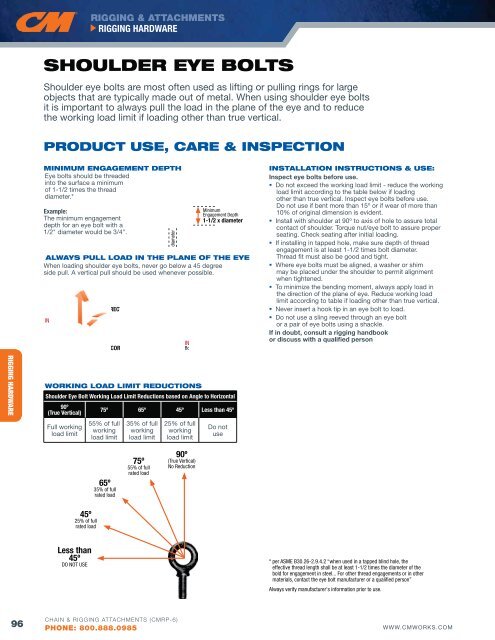zeqQT
zeqQT
zeqQT
Create successful ePaper yourself
Turn your PDF publications into a flip-book with our unique Google optimized e-Paper software.
RIGGING HARDWARE<br />
SHOULDER EYE BOLTS<br />
Shoulder eye bolts are most often used as lifting or pulling rings for large<br />
objects that are typically made out of metal. When using shoulder eye bolts<br />
it is important to always pull the load in the plane of the eye and to reduce<br />
the working load limit if loading other than true vertical.<br />
PRODUCT USE, CARE & INSPECTION<br />
MINIMUM ENGAGEMENT DEPTH<br />
Eye bolts should be threaded<br />
into the surface a minimum<br />
of 1-1/2 times the thread<br />
diameter.*<br />
Example:<br />
The minimum engagement<br />
depth for an eye bolt with a<br />
1/2" diameter would be 3/4".<br />
ALWAYS PULL LOAD IN THE PLANE OF THE EYE<br />
When loading shoulder eye bolts, never go below a 45 degree<br />
side pull. A vertical pull should be used whenever possible.<br />
INCORRECT<br />
CORRECT<br />
CORRECT<br />
CORRECT<br />
diameter<br />
INCORRECT<br />
Bolt will bend!<br />
Minimum<br />
Engagement Depth<br />
1-1/2 x diameter<br />
INSTALLATION INSTRUCTIONS & USE:<br />
Inspect eye bolts before use.<br />
• Do not exceed the working load limit - reduce the working<br />
load limit according to the table below if loading<br />
other than true vertical. Inspect eye bolts before use.<br />
Do not use if bent more than 15º or if wear of more than<br />
10% of original dimension is evident.<br />
• Install with shoulder at 90º to axis of hole to assure total<br />
contact of shoulder. Torque nut/eye bolt to assure proper<br />
seating. Check seating after initial loading.<br />
• If installing in tapped hole, make sure depth of thread<br />
engagement is at least 1-1/2 times bolt diameter.<br />
Thread fit must also be good and tight.<br />
• Where eye bolts must be aligned, a washer or shim<br />
may be placed under the shoulder to permit alignment<br />
when tightened.<br />
• To minimize the bending moment, always apply load in<br />
the direction of the plane of eye. Reduce working load<br />
limit according to table if loading other than true vertical.<br />
• Never insert a hook tip in an eye bolt to load.<br />
• Do not use a sling reeved through an eye bolt<br />
or a pair of eye bolts using a shackle.<br />
If in doubt, consult a rigging handbook<br />
or discuss with a qualified person<br />
RIGGING HARDWARE<br />
WORKING LOAD LIMIT REDUCTIONS<br />
Shoulder Eye Bolt Working Load Limit Reductions based on Angle to Horizontal<br />
90º<br />
(True Vertical)<br />
75º 65º 45º Less than 45º<br />
Full working<br />
load limit<br />
55% of full<br />
working<br />
load limit<br />
35% of full<br />
working<br />
load limit<br />
25% of full<br />
working<br />
load limit<br />
Do not<br />
use<br />
65º<br />
35% of full<br />
rated load<br />
75º<br />
55% of full<br />
rated load<br />
90º<br />
(True Vertical)<br />
No Reduction<br />
45º<br />
25% of full<br />
rated load<br />
Less than<br />
45º<br />
DO NOT USE<br />
* per ASME B30.26-2.9.4.2 “when used in a tapped blind hole, the<br />
effective thread length shall be at least 1-1/2 times the diameter of the<br />
bold for engagement in steel... For other thread engagements or in other<br />
materials, contact the eye bolt manufacturer or a qualified person”<br />
Always verify manufacturer's information prior to use.<br />
CHAIN & RIGGING ATTACHMENTS (CMRP-6)<br />
96<br />
PHONE: 800.888.0985<br />
WWW.CMWORKS.COM


